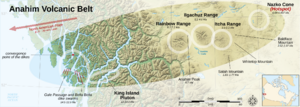Bella Bella and Gale Passage dike swarms facts for kids
The Bella Bella and Gale Passage dike swarms are two groups of parallel rock formations found along the central coast of British Columbia, Canada. These interesting formations are like ancient pathways for molten rock, called magma. They are between 14.5 and 12.5 million years old.
These rock formations are chemically "bimodal," meaning they are made of two main types of rock: basalt (a dark, common volcanic rock) and trachyte or comendite (lighter, more unusual volcanic rocks). The Bella Bella and Gale Passage dike swarms are the westernmost part of a larger volcanic area called the Anahim Volcanic Belt. You can find them on Athlone Island, Dufferin Island, and Denny Island.

Contents
What are Dike Swarms?
Imagine a giant crack in the Earth's crust. If molten rock (magma) pushes its way into that crack and then cools down, it forms a flat, wall-like rock structure called a dike. A "dike swarm" is when you have many of these dikes grouped together, often running parallel to each other.
These dike swarms are very similar to the large, dome-shaped volcanoes called shield volcanoes found in the middle of the Anahim Volcanic Belt. Scientists believe these swarms are the deep "roots" of an ancient volcanic system. They acted like pipes or tunnels, carrying magma from a deep magma chamber (a pool of molten rock underground) up to the surface. Over millions of years, the volcanoes at the surface have worn away, leaving behind only pieces of volcanic rock called breccia.
How Old Are These Rock Formations?
The Bella Bella and Gale Passage dike swarms formed a very long time ago. They are between 14.5 and 12.5 million years old. This means they were active during a period in Earth's history called the Miocene epoch. Studying their age helps scientists understand how the Earth's crust has changed over millions of years.
Where Can You Find Them?
These dike swarms are located on the Central Coast of British Columbia, Canada. Specifically, they are found on three islands:
- Athlone Island
- Dufferin Island
- Denny Island
They mark the very western edge of the larger Anahim Volcanic Belt, which stretches far inland.
What Do They Tell Us About Volcanoes?
Studying the Bella Bella and Gale Passage dike swarms helps scientists learn about ancient volcanoes. Because these dikes are the "pipes" that fed magma to volcanoes, they give us clues about:
- How magma moves through the Earth's crust.
- The types of molten rock that were present millions of years ago.
- How large volcanic systems work, even after the surface volcanoes have eroded away.
They are like a window into the past, showing us how powerful geological forces shaped the land we see today.

